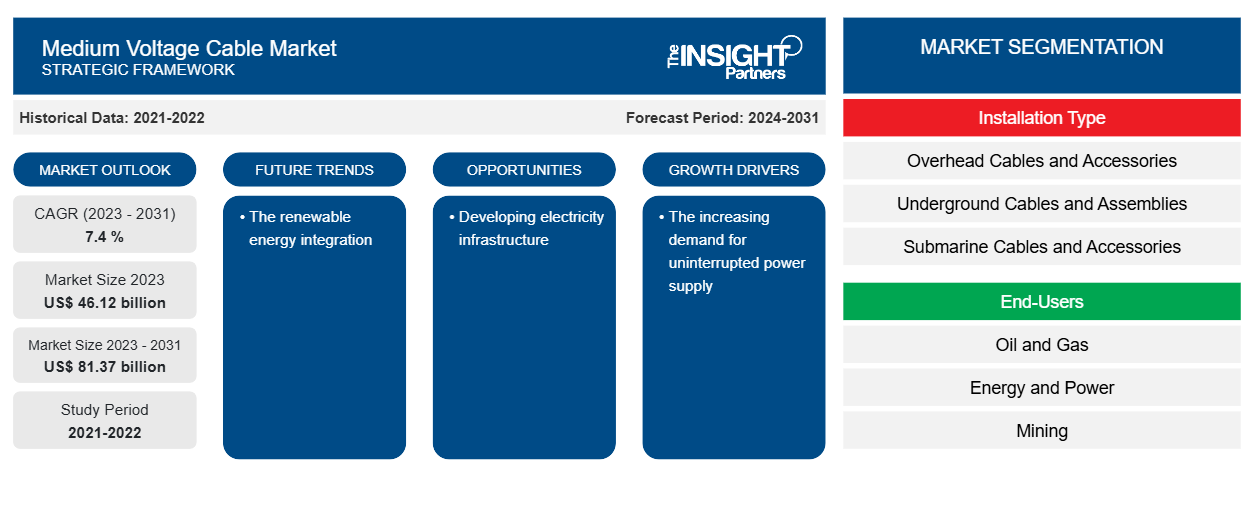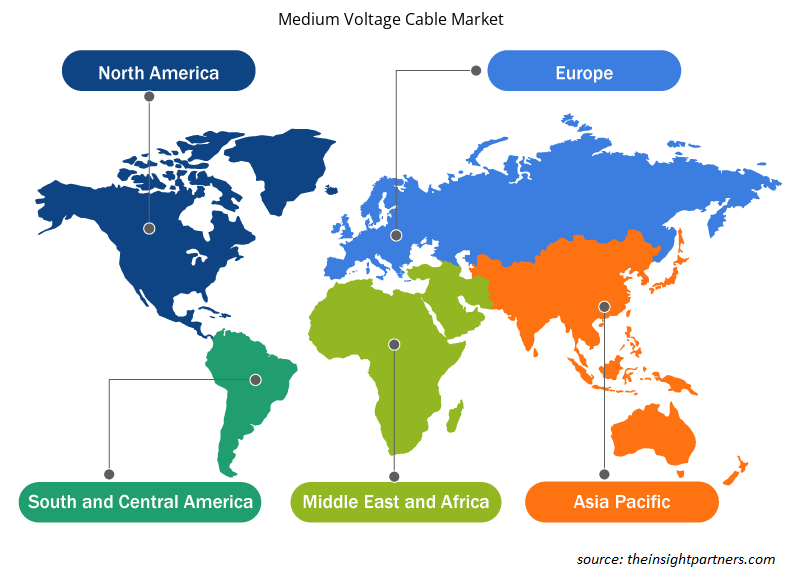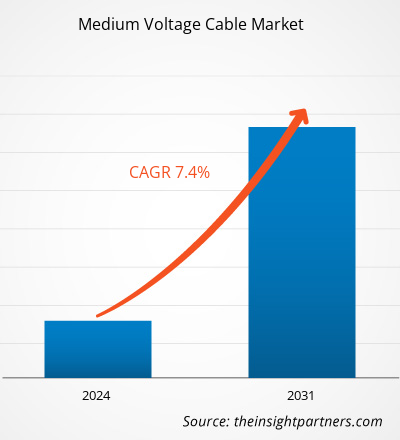Le marché des câbles moyenne tension devrait atteindre 41,28 milliards de dollars US d'ici 2031, contre 26,24 milliards de dollars US en 2024. Le marché devrait enregistrer un TCAC de 6,9 % entre 2025 et 2031. Les progrès technologiques croissants dans le domaine des câbles devraient apporter de nouvelles tendances au marché dans les années à venir.
Analyse du marché des câbles moyenne tension
La demande croissante en énergie, le développement des infrastructures et la transition vers les énergies renouvelables stimulent la demande mondiale en câbles moyenne tension. Par ailleurs, l'importance croissante accordée à la modernisation des réseaux électriques pour en améliorer l'efficacité et la fiabilité accélère la croissance du marché des câbles moyenne tension . De plus, l'adoption croissante des technologies de réseaux intelligents et des véhicules électriques nécessite une infrastructure moyenne tension fiable pour la distribution d'énergie. De plus, les avancées technologiques dans les procédés et les matériaux de fabrication des câbles, comme l'isolation en polyéthylène réticulé ( XLPE ), améliorent les performances et la longévité des câbles moyenne tension, les rendant ainsi plus attractifs pour les services publics et les utilisateurs industriels, ce qui stimule encore la croissance du marché.
Aperçu du marché des câbles moyenne tension
Les câbles électriques moyenne tension sont utilisés dans les bâtiments industriels, les projets d'énergie renouvelable et les réseaux de distribution d'électricité. Ils offrent des temps de transmission plus longs, des pertes d'énergie réduites et une fiabilité accrue. Les câbles moyenne tension font depuis longtemps partie intégrante des systèmes de distribution électrique modernes. Ils garantissent un approvisionnement en électricité efficace et fiable, répondant aux besoins quotidiens en transportant l'électricité des sous-stations vers divers points terminaux, notamment les habitations, les entreprises et les sites industriels. Cette augmentation de la demande s'explique par l'utilisation croissante de câbles moyenne tension par de nombreux secteurs industriels, conséquence de l'urbanisation, de l'industrialisation, du développement des énergies renouvelables et de l'électrification des transports.
Vous bénéficierez d'une personnalisation gratuite de n'importe quel rapport, y compris des parties de ce rapport, ou d'une analyse au niveau des pays, d'un pack de données Excel, ainsi que de superbes offres et réductions pour les start-ups et les universités.
Marché des câbles moyenne tension : perspectives stratégiques

-
Obtenez les principales tendances clés du marché de ce rapport.Cet échantillon GRATUIT comprendra une analyse de données, allant des tendances du marché aux estimations et prévisions.
Moteurs et opportunités du marché des câbles moyenne tension
Croissance du secteur des énergies renouvelables
Fin 2023, l'énergie renouvelable propre représentait 43 % de la capacité électrique installée mondiale, soit la plus forte hausse de la capacité verte, principalement due à la forte hausse de la consommation d'énergie solaire et éolienne. Par ailleurs, avec la multiplication des projets d'énergie renouvelable dans le monde, le besoin de câbles moyenne tension robustes pour connecter les installations de production d'électricité au réseau et distribuer l'électricité aux consommateurs se fait de plus en plus sentir. De plus, alors que les pays s'efforcent d'atteindre leurs objectifs en matière d'énergies renouvelables et de réduction des émissions de carbone, la demande de solutions moyenne tension efficaces devrait croître dans les années à venir. De plus, avec les modifications déjà en cours de l'infrastructure du réseau sous-jacent, la demande de câbles moyenne tension de 11 kV est en hausse à l'échelle internationale.
Innovation dans la technologie des décodeurs ( STB )
L'adoption croissante des véhicules électriques ( VE ) et l'expansion des infrastructures de recharge qui en résulte créent une opportunité considérable pour le marché des câbles moyenne tension. À mesure que de plus en plus de particuliers et d'entreprises adoptent les véhicules électriques, le besoin d'une alimentation électrique fiable pour les bornes de recharge pour VE va continuer de croître. Les câbles moyenne tension sont essentiels pour connecter les infrastructures de recharge au réseau, assurer un transfert d'énergie efficace et gérer la charge croissante des systèmes électriques existants. Les gouvernements et les entreprises investissent massivement dans les réseaux de recharge pour VE , ce qui devrait créer une opportunité de croissance pour le marché des câbles moyenne tension.
Analyse de segmentation du rapport sur le marché des câbles moyenne tension
Les segments clés qui ont contribué à l’élaboration de l’analyse du marché des câbles moyenne tension sont l’installation, la tension et l’utilisateur final.
- En fonction de l'installation, le marché se divise en deux catégories : aérien, souterrain et sous-marin. Le segment aérien est subdivisé en conducteurs en aluminium renforcés d'acier (ACSR), en conducteurs tout alliage d'aluminium (AAAC), en conducteurs en alliage d'aluminium renforcés d'acier (AACSR), etc. Le segment souterrain est subdivisé en polyéthylène réticulé (XLPE), en polychlorure de vinyle (PVC), en conducteurs recouverts de plomb et isolés au papier (PILC), etc. Le segment aérien a dominé le marché en 2024.
- En termes de tension, le marché est segmenté en 6 à 13 kV, 23 kV, 34 kV, 45 kV, 69 kV et 1 à 5 kV. Le segment 6 à 13 kV a dominé le marché en 2024.
- En termes d'utilisateurs finaux, le marché est divisé en secteurs industriel, infrastructure et énergies renouvelables. Le segment industriel a dominé le marché en 2024.
Analyse des parts de marché des câbles moyenne tension par zone géographique
Le marché des câbles moyenne tension est segmenté en cinq grandes régions : Amérique du Nord, Europe, Asie-Pacifique, Moyen-Orient et Afrique (MEA) et Amérique du Sud. L'Asie-Pacifique a dominé le marché en 2024.
L'Asie-Pacifique connaît une demande croissante de câbles moyenne tension en raison de l'urbanisation rapide, de l'industrialisation et de la hausse de la demande énergétique. Des pays comme la Chine et l'Inde stimulent cette expansion en investissant massivement dans le développement des infrastructures et des projets d'énergies renouvelables pour soutenir leurs économies en plein essor. L'importance croissante accordée aux projets de villes intelligentes et à la modernisation du réseau électrique accroît la demande de solutions moyenne tension fiables. De plus, l'utilisation croissante des véhicules électriques (VE) dans des pays comme le Japon, la Corée du Sud et l'Australie offre des perspectives considérables pour les câbles moyenne tension destinés aux infrastructures de recharge des VE. Les programmes gouvernementaux en faveur des énergies propres et du développement durable stimulent également le secteur, car ils encouragent les investissements dans les énergies renouvelables telles que l'énergie solaire et éolienne, qui nécessitent des lignes de transport moyenne tension performantes.EVs) in nations such as Japan, South Korea, and Australia presents considerable prospects for medium voltage cables to support EV charging infrastructure. Government programs supporting clean energy and sustainability are also driving the industry, since they encourage investments in renewable energy sources such as solar and wind power, which necessitate efficient medium-voltage transmission lines.
Aperçu régional du marché des câbles moyenne tension
Les tendances régionales et les facteurs influençant le marché des câbles moyenne tension tout au long de la période de prévision ont été analysés en détail par les analystes d'Insight Partners. Cette section aborde également les segments et la géographie du marché des câbles moyenne tension en Amérique du Nord, en Europe, en Asie-Pacifique, au Moyen-Orient et en Afrique, ainsi qu'en Amérique du Sud et en Amérique centrale.

- Obtenez les données régionales spécifiques au marché des câbles moyenne tension
Portée du rapport sur le marché des câbles moyenne tension
| Attribut de rapport | Détails |
|---|---|
| Taille du marché en 2024 | 26,24 milliards de dollars américains |
| Taille du marché d'ici 2031 | 41,28 milliards de dollars américains |
| TCAC mondial (2025 - 2031) | 6,9% |
| Données historiques | 2021-2023 |
| Période de prévision | 2025-2031 |
| Segments couverts |
Par installation
|
| Régions et pays couverts |
Amérique du Nord
|
| Leaders du marché et profils d'entreprises clés |
|
Densité des acteurs du marché des câbles moyenne tension : comprendre son impact sur la dynamique commerciale
Le marché des câbles moyenne tension connaît une croissance rapide, portée par une demande croissante des utilisateurs finaux, due à des facteurs tels que l'évolution des préférences des consommateurs, les avancées technologiques et une meilleure connaissance des avantages du produit. Face à cette demande croissante, les entreprises élargissent leur offre, innovent pour répondre aux besoins des consommateurs et capitalisent sur les nouvelles tendances, ce qui alimente la croissance du marché.
La densité des acteurs du marché désigne la répartition des entreprises opérant sur un marché ou un secteur particulier. Elle indique le nombre de concurrents (acteurs) présents sur un marché donné par rapport à sa taille ou à sa valeur marchande totale.
Les principales entreprises opérant sur le marché des câbles moyenne tension sont :
- ABB Ltd
- Prysmian SpA
- Nexans SA
- TE Connectivity Ltd
- Southwire Company LLC
- Houston Wire & Cable Co.
Avertissement : Les entreprises répertoriées ci-dessus ne sont pas classées dans un ordre particulier.

- Obtenez un aperçu des principaux acteurs du marché des câbles moyenne tension
Actualités et développements récents du marché des câbles moyenne tension
Le marché des câbles moyenne tension est évalué en collectant des données qualitatives et quantitatives issues d'études primaires et secondaires, notamment d'importantes publications d'entreprises, de données d'associations et de bases de données. Voici quelques-unes des évolutions du marché des câbles moyenne tension :
- Amokabel a annoncé le lancement de son nouveau câble moyenne tension, développé avec une attention particulière portée au développement durable, à la qualité et à la flexibilité, et produit à partir d'énergie 100 % renouvelable. Ce nouveau câble allie hautes performances techniques et engagement environnemental.
(Source : Amokabel, communiqué de presse, mai 2025)
- NKT investit dans des capacités de production et des capacités supplémentaires dans ses usines moyenne tension au Danemark, en Suède et en République tchèque pour répondre à la demande croissante des clients en câbles électriques moyenne tension nécessaires aux mises à niveau du réseau et aux projets d'énergie renouvelable à travers l'Europe.
(Source : NKT, communiqué de presse, avril 2024)
Rapport sur le marché des câbles moyenne tension : couverture et livrables
Le rapport « Taille et prévisions du marché des câbles moyenne tension (2021-2031) » fournit une analyse détaillée du marché couvrant les domaines mentionnés ci-dessous :
- Taille et prévisions du marché des câbles moyenne tension aux niveaux régional et national pour tous les segments de marché clés couverts par le champ d'application
- Tendances du marché des câbles moyenne tension ainsi que la dynamique du marché telles que les moteurs, les contraintes et les opportunités clés
- Analyse PEST et SWOT détaillée
- Analyse du marché des câbles moyenne tension couvrant les principales tendances du marché, le cadre régional, les principaux acteurs, les réglementations et les développements récents du marché
- Analyse du paysage industriel et de la concurrence couvrant la concentration du marché, l'analyse de la carte thermique, les principaux acteurs et les développements récents sur le marché des câbles moyenne tension
- Profils d'entreprise détaillés
- Analyse historique (2 ans), année de base, prévision (7 ans) avec TCAC
- Analyse PEST et SWOT
- Taille du marché Valeur / Volume - Mondial, Régional, Pays
- Industrie et paysage concurrentiel
- Ensemble de données Excel
Rapports récents
Rapports connexes
Témoignages
Raison d'acheter
- Prise de décision éclairée
- Compréhension de la dynamique du marché
- Analyse concurrentielle
- Connaissances clients
- Prévisions de marché
- Atténuation des risques
- Planification stratégique
- Justification des investissements
- Identification des marchés émergents
- Amélioration des stratégies marketing
- Amélioration de l'efficacité opérationnelle
- Alignement sur les tendances réglementaires






















 Obtenez un échantillon gratuit pour - Marché des câbles moyenne tension
Obtenez un échantillon gratuit pour - Marché des câbles moyenne tension